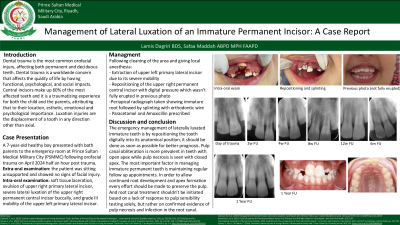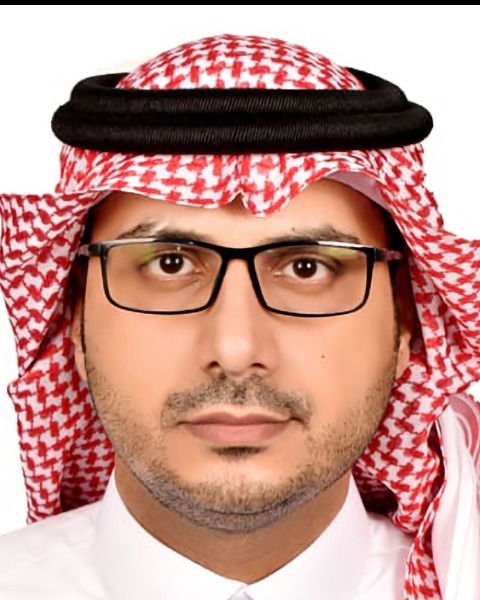Trauma
254 - Management of Lateral Luxation of an Immature Permanent Incisor: A Case Report

- LD
Lamis K. Dagriri, Bachelor of Dental Surgery, Pediatric Dentistry Resident at PSMMC (she/her/hers)
Pediatric Dentistry Resident (R2)
Prince Sultan Medical Military City in Riyadh, Saudi Arabia
Prince Sultan Medical Military City, Riyadh, Saudi Arabia
Riyadh, Ar Riyad, Saudi Arabia - SM
Safaa Maddah, American Board of Pediatric Dentistry, Master in Public Health NYU, Fellow of the American Academy of Pediatric Dentistry
Consultant Pediatric Dentist
Prince Sultan Medical Military City, Riyadh, Saudi Arabia
Riyadh, Ar Riyad, Saudi Arabia 
Abdullah S. AlKahtani, BDS, SBPD
Consultant in Pediatric Dentistry
Prince Sultan Military Medical City, Riyadh, Saudi Arabia
Riyadh, Ar Riyad, Saudi Arabia
Presenting Author(s)
Research Mentor(s)
Program Director(s)
Management of Lateral Luxation of an Immature Permanent Incisor: A Case Report
Dagriri L, Maddah S
Introduction: Dental trauma is the most common orofacial injury, affecting both permanent and deciduous teeth. Dental trauma is a worldwide concern that affects the quality of life by having functional, psychological, and social impacts. Central incisors make up 60% of the most affected teeth. Luxation injuries are the displacement of a tooth in any direction other than axial. Prognosis of luxated teeth depends on the time elapsed from the injury and the emergency treatment provided.
Case Report: Seven-year-old male patient presented to the emergency room at Prince Sultan Medical Military City
(PSMMC) following orofacial trauma. the incident has resulted in soft tissue laceration, avulsion of upper right primary lateral incisor, severe lateral luxation of the upper right permanent central incisor buccally, and grade III mobility of the upper left primary lateral incisor. This report will highlight the emergency dental management which includes repositioning and splinting, followed by regular follow ups documented with clinical and radiographic images.
The aim of presenting this report is to highlight the importance of immediate dental management by a dental practitioner as well as regular follow ups to minimize losing the tooth to trauma complications. Long-term follow up of this case is needed to assess the pulpal and periodontal health.
Six months follow up is available at the time of submission and a 1 year follow up will be available by the time of the poster presentation in May 2025.
Identify Supporting Agency and Grant Number:

.jpg)